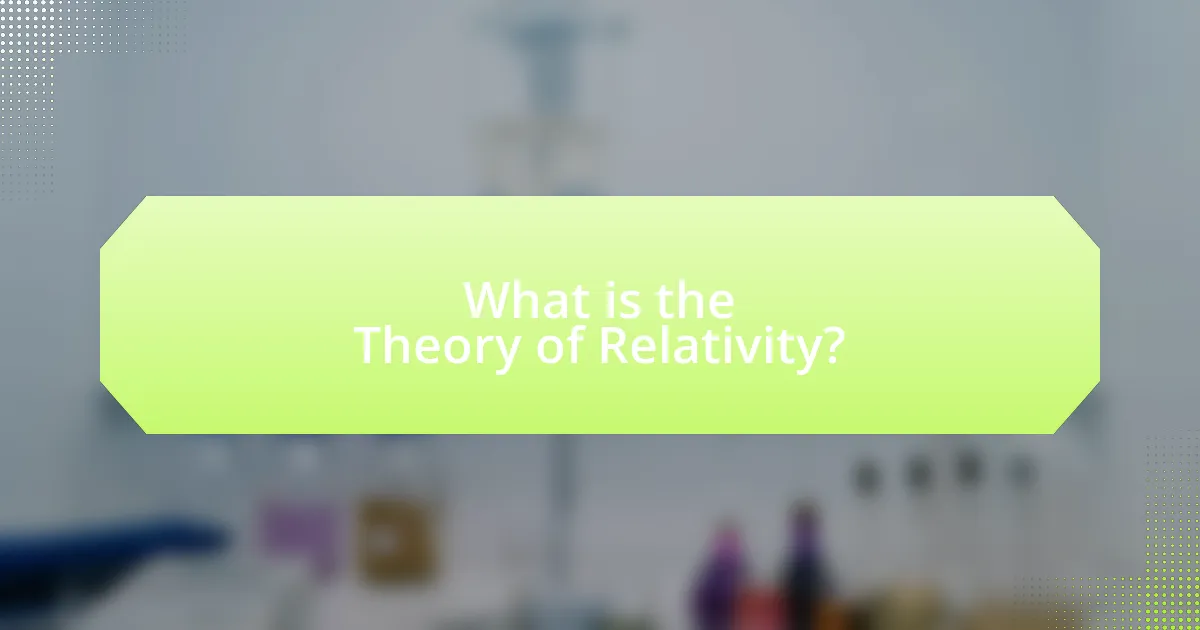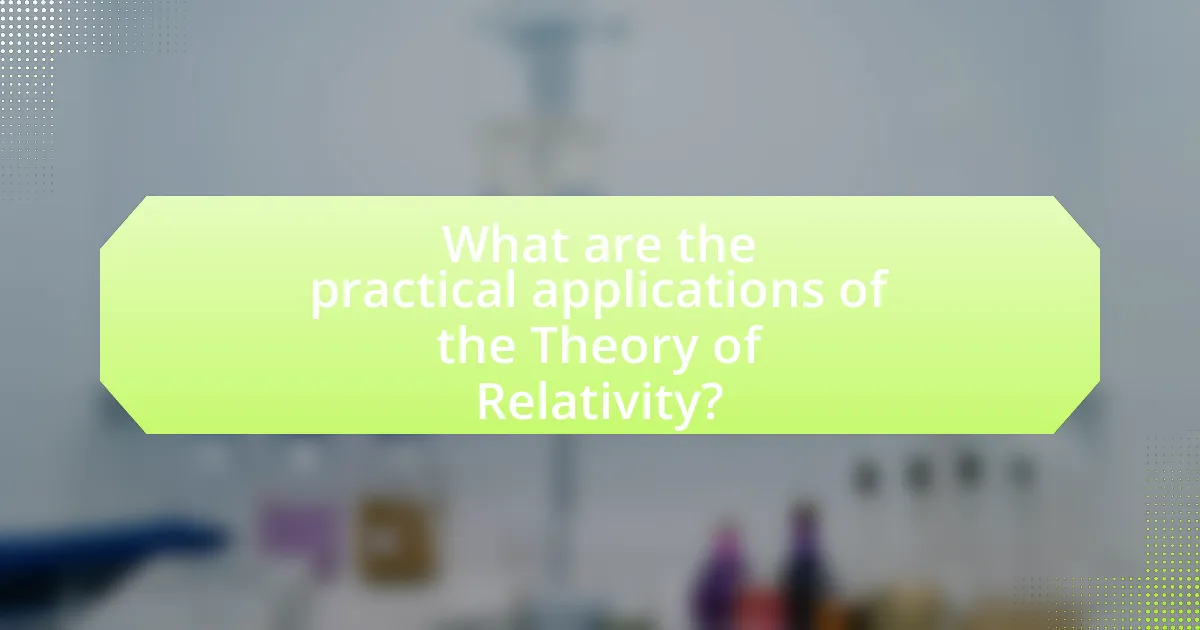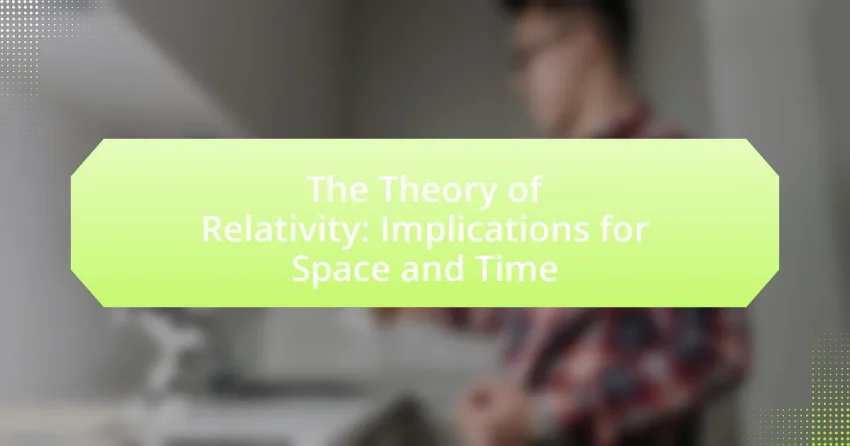The Theory of Relativity, developed by Albert Einstein, fundamentally reshapes our understanding of space, time, and gravity through its two main components: Special Relativity and General Relativity. Special Relativity addresses the physics of objects moving at constant speeds, introducing concepts such as time dilation and length contraction, while General Relativity explains how massive objects warp spacetime, influencing gravitational effects. The article explores the historical context of its development, the fundamental concepts underlying the theory, and its practical applications in modern technology, particularly in GPS systems. Additionally, it discusses the implications of relativity on our perception of distance and time, the challenges it presents in reconciling with quantum mechanics, and common misconceptions surrounding the theory.

What is the Theory of Relativity?
The Theory of Relativity is a scientific framework developed by Albert Einstein that describes the relationship between space, time, and gravity. It consists of two main components: Special Relativity, which addresses the physics of objects moving at constant speeds, particularly at speeds close to the speed of light, and General Relativity, which explains how gravity affects the fabric of space-time. Special Relativity introduced concepts such as time dilation and length contraction, demonstrating that time and space are not absolute but relative to the observer’s motion. General Relativity expanded this understanding by illustrating that massive objects like planets and stars warp space-time, causing the gravitational effects we observe. The validity of the Theory of Relativity is supported by numerous experimental confirmations, including the observation of light bending around massive objects during solar eclipses and the precise measurements of time dilation in atomic clocks on fast-moving jets.
How did the Theory of Relativity originate?
The Theory of Relativity originated from Albert Einstein’s work in the early 20th century, specifically through his 1905 paper on Special Relativity and his 1915 paper on General Relativity. Einstein developed these theories to address inconsistencies in classical mechanics and Maxwell’s equations of electromagnetism. Special Relativity introduced the concept that the laws of physics are the same for all observers in uniform motion and established the equivalence of mass and energy, encapsulated in the equation E=mc². General Relativity expanded this framework by describing gravity as the curvature of spacetime caused by mass. These theories fundamentally changed the understanding of space and time, supported by experimental evidence such as the bending of light around massive objects observed during solar eclipses.
Who was the key figure behind the Theory of Relativity?
The key figure behind the Theory of Relativity is Albert Einstein. He developed the theory in the early 20th century, with the special theory of relativity published in 1905 and the general theory of relativity in 1915. Einstein’s work fundamentally changed the understanding of space, time, and gravity, establishing that the laws of physics are the same for all observers and that the speed of light is constant in a vacuum.
What historical context influenced its development?
The development of the Theory of Relativity was influenced by the scientific advancements of the late 19th and early 20th centuries, particularly the emergence of electromagnetism and the inadequacies of classical mechanics. Albert Einstein formulated his theories in a context where classical Newtonian physics could not adequately explain phenomena such as the behavior of light and the results of the Michelson-Morley experiment, which failed to detect the expected ether wind. This historical backdrop of scientific inquiry and the quest for a unified understanding of space and time led to the revolutionary concepts of special relativity in 1905 and general relativity in 1915, fundamentally altering the perception of gravity and the fabric of the universe.
What are the fundamental concepts of the Theory of Relativity?
The fundamental concepts of the Theory of Relativity include the principles of time dilation, length contraction, and the equivalence of mass and energy. Time dilation states that time passes at different rates for observers in different frames of reference, particularly at high velocities, as demonstrated by experiments with atomic clocks on fast-moving jets. Length contraction indicates that objects appear shorter in the direction of motion when traveling close to the speed of light, a phenomenon confirmed by particle accelerator experiments. The equivalence of mass and energy is encapsulated in the equation E=mc², which shows that mass can be converted into energy and vice versa, a principle validated by nuclear reactions. These concepts fundamentally alter our understanding of space and time, illustrating that they are interconnected and relative rather than absolute.
What is the difference between Special and General Relativity?
Special Relativity and General Relativity are two theories proposed by Albert Einstein that describe the behavior of objects in space and time. Special Relativity, introduced in 1905, focuses on the physics of objects moving at constant speeds, particularly at speeds close to the speed of light, and establishes that the laws of physics are the same for all observers in uniform motion relative to one another. It introduces the concept that time and space are interwoven into a single continuum known as spacetime, and it leads to the famous equation E=mc², which shows the equivalence of mass and energy.
In contrast, General Relativity, published in 1915, extends the principles of Special Relativity to include acceleration and gravity. It posits that massive objects cause a curvature in spacetime, which is perceived as gravity. This theory explains phenomena such as the bending of light around massive objects and the precession of planetary orbits. General Relativity has been confirmed through various experiments, such as the observation of gravitational waves and the bending of light during solar eclipses.
Thus, the primary difference lies in their scope: Special Relativity deals with inertial frames and constant velocities, while General Relativity encompasses acceleration and gravitational effects.
How do space and time interrelate according to this theory?
According to the Theory of Relativity, space and time are interrelated as a single continuum known as spacetime. This theory, formulated by Albert Einstein, posits that the dimensions of space and time are not independent; rather, they are interconnected and influence each other. For instance, the presence of mass can warp spacetime, leading to the phenomenon of gravity, which affects the passage of time. This relationship is evidenced by experiments such as the observation of time dilation, where time moves slower in stronger gravitational fields, confirming that time is affected by spatial dimensions and mass.

How does the Theory of Relativity impact our understanding of space?
The Theory of Relativity fundamentally alters our understanding of space by demonstrating that space is not a fixed, absolute entity but is instead intertwined with time and influenced by mass and energy. This theory, proposed by Albert Einstein in the early 20th century, introduces the concept that the fabric of space can be warped by gravitational forces, leading to phenomena such as time dilation and the curvature of space around massive objects. For instance, the observation of light bending around the sun during a solar eclipse in 1919 provided empirical evidence supporting this theory, confirming that massive bodies can indeed affect the geometry of space. Thus, the Theory of Relativity reshapes our perception of space as a dynamic and relative construct rather than a static backdrop.
What are the implications of relativity on the concept of space?
Relativity fundamentally alters the concept of space by introducing the idea that space is not a fixed, absolute entity but is instead intertwined with time and influenced by mass and energy. According to Einstein’s theory, the presence of mass warps the fabric of space-time, leading to phenomena such as gravitational time dilation and the curvature of light paths around massive objects. This means that measurements of space can vary depending on the observer’s relative motion and gravitational field, as demonstrated by experiments such as the observation of light bending around the sun during a solar eclipse in 1919, which confirmed predictions made by general relativity. Thus, relativity reshapes our understanding of space as a dynamic and relative construct rather than a static backdrop.
How does relativity alter our perception of distance?
Relativity alters our perception of distance by demonstrating that measurements of space can vary depending on the relative motion of observers. According to Einstein’s theory of relativity, as an object approaches the speed of light, distances appear contracted to an observer in a different frame of reference. This phenomenon, known as length contraction, means that two observers moving relative to each other will measure different distances for the same object. For example, in the famous thought experiment involving a moving spaceship, an observer on the spaceship would measure a shorter distance to a star than an observer on Earth would measure. This principle is supported by experimental evidence, such as the observations of muons created by cosmic rays, which travel at relativistic speeds and decay more slowly than expected due to their high velocity, indicating that time and distance are interrelated in a relativistic framework.
What role does gravity play in the structure of space?
Gravity is a fundamental force that shapes the structure of space by influencing the curvature of spacetime. According to Einstein’s General Theory of Relativity, massive objects like planets and stars create a distortion in the fabric of spacetime, causing other objects to follow curved paths around them. This curvature is what we perceive as gravity, and it dictates the motion of celestial bodies, the formation of galaxies, and the overall structure of the universe. Observations, such as the bending of light around massive objects (gravitational lensing), provide concrete evidence of gravity’s role in shaping space.
How does the Theory of Relativity influence time perception?
The Theory of Relativity influences time perception by demonstrating that time is not a constant, but rather varies depending on the relative speed of observers and the presence of gravitational fields. According to Einstein’s theory, time dilates, meaning that time moves slower for objects moving at high speeds compared to those at rest, as evidenced by experiments involving atomic clocks on fast-moving jets, which showed measurable differences in elapsed time. Additionally, in strong gravitational fields, such as near a black hole, time also slows down relative to areas with weaker gravity, a phenomenon confirmed by observations of time discrepancies in GPS satellites, which must account for both special and general relativity to maintain accuracy.
What is time dilation and how does it occur?
Time dilation is the phenomenon where time passes at different rates for observers in different frames of reference, particularly when one is moving at a significant fraction of the speed of light or is in a strong gravitational field. This effect occurs due to the principles outlined in Einstein’s Theory of Relativity, which states that the laws of physics are the same for all observers, and that the speed of light is constant regardless of the observer’s motion.
For example, an observer traveling at a high velocity will experience time more slowly compared to a stationary observer, a consequence of the Lorentz transformation equations derived from special relativity. Additionally, in general relativity, time runs slower in stronger gravitational fields, as demonstrated by experiments involving precise atomic clocks placed at different altitudes, which confirm that clocks at higher altitudes (weaker gravity) tick faster than those at lower altitudes (stronger gravity).
How does the theory redefine simultaneity?
The theory of relativity redefines simultaneity by establishing that events perceived as simultaneous by one observer may not be simultaneous for another observer moving relative to the first. This concept is rooted in the idea that the speed of light is constant for all observers, leading to the conclusion that time is not absolute but relative to the observer’s frame of reference. For example, in Einstein’s thought experiment involving two lightning strikes hitting a moving train, observers on the train and on the ground will disagree on the simultaneity of the strikes due to their different velocities. This fundamentally alters the classical notion of time and simultaneity, demonstrating that measurements of time can vary based on relative motion.

What are the practical applications of the Theory of Relativity?
The practical applications of the Theory of Relativity include GPS technology, nuclear energy, and understanding gravitational waves. GPS relies on both special and general relativity to provide accurate positioning; satellites experience time differently due to their speed and gravitational field, requiring adjustments to maintain precision. Nuclear energy, as described by Einstein’s mass-energy equivalence (E=mc²), underpins the functioning of nuclear reactors and weapons. Additionally, the detection of gravitational waves, confirmed by LIGO in 2015, has opened new avenues in astrophysics, allowing scientists to observe cosmic events and test the predictions of relativity.
How is the Theory of Relativity applied in modern technology?
The Theory of Relativity is applied in modern technology primarily through the Global Positioning System (GPS), which relies on precise time measurements affected by relativistic effects. GPS satellites experience time dilation due to their high speeds and the weaker gravitational field in orbit compared to the Earth’s surface, causing their onboard clocks to tick slightly faster than those on Earth. This discrepancy, approximately 38 microseconds per day, must be corrected to ensure accurate positioning data. Without accounting for these relativistic effects, GPS calculations would yield significant errors, leading to inaccuracies in navigation and location services.
What role does it play in GPS technology?
The Theory of Relativity plays a crucial role in GPS technology by ensuring accurate positioning and timing. GPS satellites orbit the Earth at high speeds and experience weaker gravitational fields compared to objects on the surface, leading to time dilation effects as predicted by Einstein’s theory. This means that time on the satellites runs faster than on Earth, necessitating adjustments to synchronize satellite clocks with ground-based systems. Without accounting for these relativistic effects, GPS calculations would yield errors of up to 10 kilometers per day, significantly impairing the system’s functionality.
How does it affect our understanding of the universe in astrophysics?
The Theory of Relativity fundamentally alters our understanding of the universe in astrophysics by demonstrating that space and time are interconnected and relative rather than absolute. This theory, proposed by Albert Einstein, reveals that massive objects can warp spacetime, leading to phenomena such as gravitational time dilation and the bending of light around massive bodies, which has been confirmed through observations like the bending of starlight during solar eclipses. These insights have profound implications for cosmology, influencing models of the universe’s expansion and the behavior of black holes, thereby reshaping our comprehension of gravitational forces and the overall structure of the cosmos.
What challenges arise from the Theory of Relativity?
The challenges arising from the Theory of Relativity include difficulties in reconciling it with quantum mechanics, the implications of time dilation on GPS technology, and the complexities of understanding black holes. The incompatibility between general relativity and quantum mechanics presents a significant challenge, as both frameworks describe fundamental aspects of the universe but operate under different principles. For instance, while general relativity explains gravity on a large scale, quantum mechanics governs the behavior of particles at the smallest scales, leading to unresolved questions about the nature of spacetime. Additionally, time dilation, a consequence of relativity, affects satellite systems like GPS, requiring adjustments to maintain accuracy, as satellites experience time differently than observers on Earth. Lastly, the nature of black holes, predicted by general relativity, raises questions about singularities and the information paradox, challenging our understanding of physics at extreme conditions.
What are the common misconceptions about relativity?
Common misconceptions about relativity include the belief that it implies time travel is possible, that it suggests faster-than-light travel is achievable, and that it means time is the same for everyone regardless of their relative motion. Time travel is not supported by relativity; instead, it describes how time can appear to pass at different rates for observers in different frames of reference, as demonstrated by the twin paradox. Faster-than-light travel contradicts the theory, as it would require infinite energy according to Einstein’s equations. Additionally, relativity asserts that time is relative and depends on the observer’s velocity, meaning that two observers moving at different speeds will measure different times for the same event, as confirmed by numerous experiments, including those involving atomic clocks on fast-moving jets.
How do scientists address the limitations of the Theory of Relativity?
Scientists address the limitations of the Theory of Relativity by developing alternative theories and conducting experiments to test its predictions. For instance, string theory and loop quantum gravity are proposed frameworks that aim to unify general relativity with quantum mechanics, addressing phenomena like black hole singularities and the behavior of spacetime at the quantum level. Additionally, experiments such as those conducted by the LIGO collaboration have provided insights into gravitational waves, further validating aspects of relativity while also highlighting areas needing refinement. These approaches demonstrate an ongoing effort to reconcile the theory with new empirical data and theoretical advancements.
What are some best practices for understanding the Theory of Relativity?
To understand the Theory of Relativity effectively, one should start by studying the fundamental concepts of space and time as defined by Albert Einstein. Engaging with introductory texts, such as “Relativity: The Special and the General Theory” by Einstein himself, provides foundational knowledge. Additionally, utilizing visual aids like spacetime diagrams can clarify complex ideas, as they illustrate the relationship between time and space in a more digestible format.
Practicing problem-solving with real-world scenarios, such as calculating time dilation or gravitational effects, reinforces theoretical understanding. Online courses or lectures from reputable institutions, like MIT’s OpenCourseWare, offer structured learning paths and expert insights.
Lastly, discussing concepts with peers or joining study groups can enhance comprehension through collaborative learning, allowing for the exchange of different perspectives and clarifications on challenging topics.
